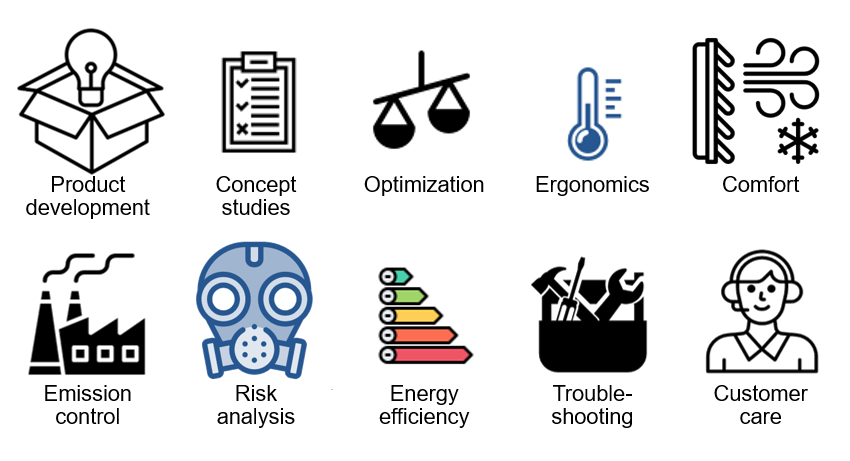30/06/2020
Not only colorful pictures – CFD saves time and money
Did you know that by using computational fluid dynamics (CFD) you can save as much as 80 % in design time and 60 % in design costs? During the past 20 years, I’ve been lucky enough to participate in many interesting simulation projects both in Finland and abroad and have seen how clients have received instant help. But what is CFD really? Where can it be applied and why should it be utilized?
Let’s start with an example from real life where we assume that the salaries of a lab engineer and a simulation engineer are the same. It is also assumed that the initial costs for lab equipment and simulation software are equivalent.
In this specific project, altogether 48 different simulations were performed for a device, which was still under development. In calendar time, these simulations took about one year, along with some other projects. If the same concepts had been studied in a laboratory, it would have taken 240 weeks, which is almost five years! This is the result, if we are fairly optimistic and assume that the manufacturing of a new prototype takes four weeks and measurements only one week.
In real life, this was not possible since 11 of the simulated cases couldn’t be measured at all due to the complex set-up requirements. The rest of the concepts would have required 38 different prototypes. If one costs 1000 euros, the total cost would have been 38 000 euros for prototypes only.
If the cost of the annual technical support and license fee for all simulations during that year is considered, the cost of simulations would only be 40 % of that of prototypes. Isn’t having simulations done like laughing all the way to the bank?
To summarize: based on the simulations, a single prototype was needed to verify the measurements. This took only 20 % of the time that testing would have taken and cost only 40 % of what testing would have.
What is CFD?
Computational fluid dynamics (CFD) is a branch of fluid mechanics: a science that uses numerical methods to predict fluid flows and heat and mass transfers. A complex set of equations describing the conservation of momentum, mass and energy are solved iteratively using supercomputers.
Because of the abbreviation “CFD”, it is often referred to as “colorful fluid dynamics”, due to the common way to present quantitative results as colorful pictures. It may not require much to produce colorful pictures, but to really get something out of a simulation a skilled simulation engineer, state-of-the-art software, and powerful computational resources are needed. I won’t dig into the theory but discuss instead why and when CFD should be used.
Why should CFD be used?
In a traditional product development project, each idea is first designed and then tested by ordering a prototype. It is measured in the lab using a specific test set-up, after which the results are analyzed and fed back to design for the required modifications. This cycle is then repeated until the desired design is reached. The procedure is very time consuming and expensive as multiple prototypes are required.
When computational fluid dynamics is integrated as a part of product development, many benefits are achieved.


When a design engineer and simulation engineer work together right from the beginning, analysis can be performed for a product or process that doesn’t exist yet.
The analysis helps one to understand phenomena, which might be impossible to measure. Like in the real-life example, usually at least one prototype is manufactured for verification of the simulation results, but even this is not always possible. The final product might be a 40-meter-high industrial boiler or deposition facility for nuclear waste, which is currently under construction. Then simulations play even a bigger role. If simulations were not used, most likely only a few of prototypes would be built in order to save money. With the help of CFD, even wild ideas can be tested by thinking outside the box. One of these crazy ideas might be just the one that ends up in the final design.
As a result, the final product is finished faster i.e. time-to-market is shorter. We also achieve significant savings, since there is no need to build an extensive number of prototypes and test them. Everyone’s knowledge on the product increases simulation by simulation, and this knowledge can then be used further in similar projects or, for example, in customer care when the product is already on the market. But what is most important: by using simulations we can ensure that the final product is functional, safe and ecological.
When should CFD be used?
CFD analysis can be applied almost everywhere! We can study internal flows, for example, the flow in a duct. We can study external flows, for example, the flow over a car to create as aerodynamic a design as possible. We can study environmental flows, for example, air flows in a city center to determine how wind affects pedestrian comfort.
In CFD, size doesn’t matter. Many applications, which in real life are very different in size, might in fact be very similar on the computer screen. The physics of ventilation is very similar compared to the physics of desktop cooling, just to mention one.
Simulations should be applied as early as possible. Usually, decisions made early in the design process define the biggest part of the total cost of the project. The biggest advantage is reached when, based on the simulation results, changes really can be made. If the majority of the design parameters are already locked, the most optimal solution might be out of the question. It’s important to remember that for simulation purposes, the device does not need to be final.
Numerous applications

There are numerous applications where computational fluid dynamics brings benefits:
- Concept design: when the basic idea for a new project is selected
- Evaluation of a business idea: are there any risks or risks worth taking?
- Product development: e.g. design of a new battery-driven drill
- Optimization: improving an existing application or e.g. pursuing maximum heat transfer ability for a heatsink with minimum weight
- Ergonomics: e.g. ensuring sufficiently low temperature on the handle of a battery-driven drill
- Comfort: e.g. ensuring there is no windchill effect next to an air conditioning unit
- Emission control: source can be e.g. a car or a factory, target can be e.g. as low Nitrogen Oxide (NOx) emissions as possible
- Risk analysis: how hazardous substances, fires or pressure waves from explosions advance in an urban environment
- Energy efficiency: e.g. reducing hydrodynamic resistance of a ship in order to reduce fuel consumption
- Troubleshooting: when product or process does not work as expected
- Digital twin: model for searching the limits of a running device and maintaining it
- Customer care: when the product or process is thoroughly known, the customer can be served and helped better
Finally
You might already have a question you want to have answered, or goal you want to accomplish. Most likely, you have most of what is required to perform a simulation, such as a 3D CAD model, a description of the product or process, and the circumstances where it is used. With the help of computational fluid dynamics, it is then easy to ensure that your end product or process is functional, safe and environmentally friendly.
Want to know more? Check out these related articles:
Fluid Dynamics
With our Computational Fluid Dynamics (CFD) services, you can analyze the fluid dynamics and heat or mass transfer of fluids and thereby develop your products. You also save time and money.
Do you produce equipment that makes everyday life easier or better or creates a safe environment? By making use of our modeling services, you can ensure its functionality and optimal performance.
Computational fluid dynamics in aerodynamic and light structures
If you are looking for an expert in computational fluid dynamics, we are the right partner for you. Our team represents the cutting edge of research on aerodynamic and lightweight structures in Finland.

